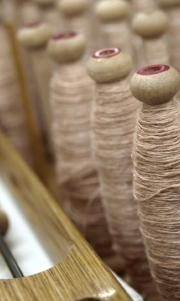From the collection and processing of natural fibers which are extracted from plants to make the dyes, to the weaving itself, every step of the creation of Chibana-Hanaori is done completely by hand.

◆ The Dyeing Process
・ Ryukyu indigo and awamori are combined,mixed
and naturally fermented.
・ The threads are dyed numerous times.
・ Ryukyu indigo in the fermentation stage.
The plants that are used to make the dyes for Chibana-Hanaori are collected in the woods in the area, including those in the Chibana Gusuku castle ruins, which still remains in this district.

 前のページへ
前のページへ
|1|
次のページへ










